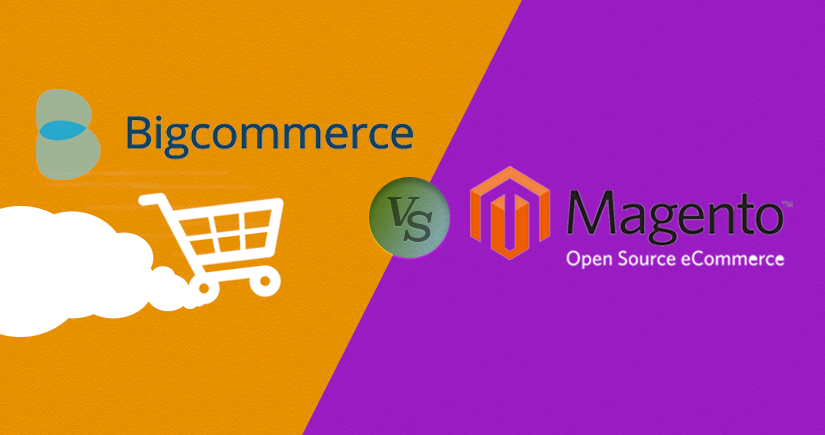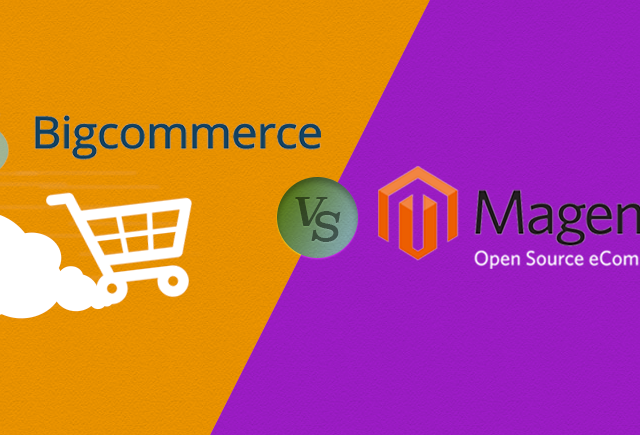BigCommerce or Magento: Which is best?
Can’t decide between BigCommerce and Magento?
Find the best platform for you with our side by side comparison of BigCommerce and Magento. See how each platform stacks up across ease of use, design, support and value for money.
Is BigCommerce right for you?
BigCommerce is a popular ecommerce platform with a number of solutions for small and medium-sized retailers. Custom enterprise plans are also available.
BigCommerce appeals particularly to users with limited development skills because of its usability out-of-the-box. That said, those wishing to make more complex backend changes can do so.
Smaller retailers experiencing growth are also drawn to BigCommerce because of its scalability features. The BigCommerce feature-set has everything you would expect, including responsive website templates, shopping cart, and payment integrations, single-page checkout, analytics, and more.
Retailers looking for a fully-hosted solution at a reasonable price point will find BigCommerce appealing. Customer service ratings are consistently high, and BigCommerce customers can take advantage of an active, helpful community of fellow users.
Advantages
- Easy-to-use from the get-go and fully hosted, which removes the hassle of maintaining servers.
- A wide selection of features with regular updates and a diverse addon market (with many free options).
- No transaction fees for use of popular payment gateways.
Drawbacks
- Some features, like price lists, are only available on the more expensive plans.
- Can be difficult to make extensive design and backend changes.
- Themes and add-ons are often quite expensive.
Use if you are a small to medium-sized retailer with limited development skills (or budget) and expecting your store to grow.
Is Magento right for you?
Magento is an open-source ecommerce platform owned by Adobe which is offered in a range of formats. The best-known option is a completely free, open-source version called “Magento Open Source”. Retailers that want to use the platform while taking advantage of cloud hosting, customer support, and additional functionality, can opt for one of the paid options under the “Magento Commerce” banner.
Because of its extensive feature-set, scalability, high customizability, and popularity among developers, Magento is particularly suitable for retailers running larger stores. Medium-sized retailers that need a comprehensive and feature-rich solution will also be drawn to Magento.
For smaller retailers without any development experience, however, a more user-friendly and streamlined solution will probably be preferable.
Advantages
- Open source version is free.
- Powerful, feature-rich solution that scales easily.
- Completely customizable.
Drawbacks
- Paid plans are expensive.
- Open-source version will be virtually impossible to use for retailers without in-house coding expertise.
- Extensions are expensive.
If you’re a large retailer that needs a customizable, powerful solution through which you can manage multiple sites in different countries. Remember to take care of hosting, security, and troubleshooting yourself if you opt for the open source version.
Is BigCommerce SAAS?
Yes, bigCommerce is a fully-hosted SAAS option. You don’t need your own server host to run it.
Is Magento SAAS?
No, Magento is not SAAS. You will need to download and install the Magento code on your own server and therefore you will need to factor in hosting costs.
Magento Setup costs
A major bonus: there are no setup charges or transaction fees to use Magento. However, in order to set up the online store you want, there are a significant number of other set-up costs including payment gateways, SSL certificates, product and shipping plugins which can cost several thousand pounds. Not forgetting that, unless you’re technically savvy, you’ll need a developer to configure Magento for you.
BigCommerce Setup costs
BigCommerce is a Software as a Service (SaaS) platform which means set up costs are lower that eCommerce software that requires a web host. All you will need to pay for is a theme template, and possible development together with the signing on fee for the package of your choice.
New businesses are best advised to start with either the Standard or Plus plans and pay for the entire year so you get a 10% discount. Templates can be grabbed for free and there are other free features such as a handful of shopping feed plugins, such as integration with Google PLA (Google Shopping) that can help you grow without having to shell out setup fees. You can start an online store on BigCommerce for less than £1000, and even less than £100 if you go for a basic template and only pay the monthly sign on fee.
BigCommerce Monthly costs
The pricing packages at BigCommerce may appear slightly higher than its closet competitors, but the company does not charge transactions fees like Shopify or add-ons to boost performance like WooCommerce. Over the long term, monthly running costs are probably less than other options. You will still need to pay the processing fees charged by banks and payment gateways, but that is standard across all ecommerce platforms.
However, there is one slight catch. Once you exceed the annual sales threshold BigCommerce has capped under any one pricing plan, they insist you move up to the next package. In one sense, this gives you more tools to improve your online store, but also means your monthly expenses increase. The steep rise from a Plus account to a Pro account could cause a setback for some businesses.
BigCommerce pricing packages:
| Package | Monthly Fee | Products | Storage | Bandwidth | Revenue threshold |
| Standard | $29.95+/£22.50 | Unlimited | Unlimited | Unlimited | Up to $50,000/ |
| Plus | $79.95+/£60 | Unlimited | Unlimited | Unlimited | Up to $150,000/ |
| Pro | $249.95+/£188.50 | Unlimited | Unlimited | Unlimited | Up to $1,000,000 |
| Enterprise | Custom | Unlimited | Unlimited | Unlimited | Unlimited |
If you’re not sure whether BigCommerce software is the best option for you, customers are offered a 15-day free trial without you having to hand over your credit card details.
Magento Monthly Costs
Magento targets large enterprises so is not the cheapest eCommerce software around as you have to factor in setup costs which usually involve an agency or specialist developer.
In addition to set-up fees, there are a number of other costs to take into consideration; hosting, payment gateways, development, and various set up costs. It is estimated that the annual running costs for a basic Community Magento Edition (CE) will set you back between £1,000 and £5,000, which equates to the costs of your server hosting fees, plus minor additions like SSL certificates, renewing plugins, etc.
Large eCommerce companies typically need the Magento Enterprise platform which cost between £20,000 and £580,000 a year to run, develop and maintain. The exact pricing plans for Magento vary quite widely as you can choose between the (self-hosted) Enterprise Edition or the Magento-hosted cloud version Enterprise Cloud Edition.
Ease of Use
Our first comparison criteria, ease of use. Why? Because it’s the most important.
Think about it. You don’t want to invest a lot of your precious time setting up an online store and tweaking the design only to find out that it’s a pain in the butt to manage day to day.
We take a look at how simple the BigCommerce and Magento platforms are to run.
How easy is BigCommerce to use?
BigCommerce is very easy to use. After signing up, you’ll be guided through the process of setting up your store.
You can access essential features from the central BigCommerce dashboard, including product listings, customer information, analytics, app integrations, and more. Once your store is ready to go, day-to-day tasks of managing orders and content can be handled easily through the main interface. Adding new products and running reports are straightforward tasks.
One reason that BigCommerce doesn’t score a straight 10 out of 10 is because designing extra functionality beyond what’s offered directly can be tricky.
How easy is Magento to use?
While advanced development knowledge is required to run the open-source and paid enterprise version of Magento, the management dashboard itself is pretty intuitive. That said, Magento does have a very large feature-set, so there’s a learning curve for new users.
The small business version has a page-builder for ease-of-use and assistance is available for getting set up. Smaller retailers interested in Magento should try the free trial to see if it fits with their needs.
BigCommerce Payment options
BigCommerce integrates with around 60 payment gateways, which is substantially more than any of its competitors.
Magento Payment Options
The payment options in the Magento software has everything you would expect from an enterprise level software. Businesses can offer customers several gateway options, more than other eCommerce sites. This gives you more flexibility and professionalism.
Magento is compatible with PayPal, Simple Pay, Amazon Payments, Google Checkout and Authorize.net. Furthermore, there are no transactions fees or what customers may deem as ‘hidden costs’ – tax and shipping costs are built into the total invoice amount before customers head to checkout.
Another advantage of the Magento payment options is the “bill me later” program. This gives buyers the opportunity to set up convenient and affordable direct debits whereby they make monthly payments rather than a one-off payment. This is a feature online buyers appreciate for expensive items.
BigCommerce Customer support options
Customer support lines are open 24/7 and includes phone support, online chat and email. Users also have access to video tutorials and online forums where you can tap into the vast knowledge base of other users.
Magento Customer Support Options
Businesses that opt for the Magento CE are without technical support other than a users forum where you can tap into a huge knowledge base of active users. The Magento EE version does offer a tech support team.
Summing Up
BigCommerce is best for those who need to get a large, fast-growing business up and running online quickly, whereas Magento is for technically savvy business owners who don’t mind spending time customizing their store with code.
BigCommerce is fairly simple to use, and provides all the tools required to build an ecommerce empire. While it takes longer to build an ecommerce website with Magento, the platform does offer total creative freedom, which may appeal to perfectionists.
Overall, we’re giving the thumbs up – and ceremonial wooden sword – to BigCommerce.
When it comes to building your online store, it’s the complete package. Everything you need for your store to flourish is right there in the dashboard, so with BigCommerce, you really can dream big.





